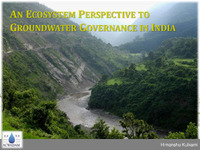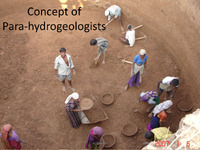Items
Tag
aquifers
-
 AN ECOSYSTEM PERSPECTIVE TO GROUNDWATER GOVERNANCE IN INDIA The governance of groundwater in India faces significant challenges due to varying aquifer types, overexploitation, and climate change impacts. With over 30 million wells, groundwater serves as a critical resource for both domestic and industrial use, despite being underutilized and poorly managed in many regions. Effective groundwater management requires a comprehensive understanding of aquifer dynamics, community participation, and regulatory frameworks that balance extraction with sustainability. Prioritizing equitable access, protecting recharge areas, and engaging users in decision-making are essential for addressing water scarcity and ensuring long-term water security across diverse ecosystems.
AN ECOSYSTEM PERSPECTIVE TO GROUNDWATER GOVERNANCE IN INDIA The governance of groundwater in India faces significant challenges due to varying aquifer types, overexploitation, and climate change impacts. With over 30 million wells, groundwater serves as a critical resource for both domestic and industrial use, despite being underutilized and poorly managed in many regions. Effective groundwater management requires a comprehensive understanding of aquifer dynamics, community participation, and regulatory frameworks that balance extraction with sustainability. Prioritizing equitable access, protecting recharge areas, and engaging users in decision-making are essential for addressing water scarcity and ensuring long-term water security across diverse ecosystems. -
 SPRINGS : IMPORTANT HYDROGEOLOGICAL ASPECTS Springs are vital hydrogeological resources shared among users, with access often through common sources. Effective management requires mapping and characterizing springs, assessing their geological features, and monitoring factors like discharge and water quality. Community involvement is crucial for data collection and decision-making in spring management. Springs vary greatly in their discharge characteristics and aquifer types, influencing their recharge dynamics and water quality. Strategies for capacity building include planning interventions for recharge and protection, ultimately aiming for sustainable use of these essential water sources.
SPRINGS : IMPORTANT HYDROGEOLOGICAL ASPECTS Springs are vital hydrogeological resources shared among users, with access often through common sources. Effective management requires mapping and characterizing springs, assessing their geological features, and monitoring factors like discharge and water quality. Community involvement is crucial for data collection and decision-making in spring management. Springs vary greatly in their discharge characteristics and aquifer types, influencing their recharge dynamics and water quality. Strategies for capacity building include planning interventions for recharge and protection, ultimately aiming for sustainable use of these essential water sources. -
 Pumping Test methodology Pumping tests are essential procedures used to evaluate how aquifers respond to water extraction from wells. They help well-owners determine their well's yield, the appropriate pump capacity, and aquifer characteristics like Transmissivity and Storativity. The tests involve pumping water from a well, measuring the resulting changes in water levels in both the pumping and nearby observation wells. There are two main types of tests: well tests, focusing on the well's performance, and aquifer performance tests, which assess aquifer properties. Data collected during these tests informs on drawdown, recovery rates, and the aquifer's behavior under varying pumping conditions.
Pumping Test methodology Pumping tests are essential procedures used to evaluate how aquifers respond to water extraction from wells. They help well-owners determine their well's yield, the appropriate pump capacity, and aquifer characteristics like Transmissivity and Storativity. The tests involve pumping water from a well, measuring the resulting changes in water levels in both the pumping and nearby observation wells. There are two main types of tests: well tests, focusing on the well's performance, and aquifer performance tests, which assess aquifer properties. Data collected during these tests informs on drawdown, recovery rates, and the aquifer's behavior under varying pumping conditions. -
 Introduction to springs The document discusses the significance of springs, particularly in India, highlighting their role as natural groundwater discharge points that sustain streams and rivers. It outlines the extensive presence of springs across various regions, including the Himalayas and Western Ghats, and notes the lack of comprehensive data on groundwater resources. Springs are categorized into different types based on their formation processes, such as depression, fracture, and karst springs. The text emphasizes the need to shift focus from viewing groundwater merely as a source to understanding it as a vital resource, advocating for improved monitoring and management practices to ensure water quality and availability.
Introduction to springs The document discusses the significance of springs, particularly in India, highlighting their role as natural groundwater discharge points that sustain streams and rivers. It outlines the extensive presence of springs across various regions, including the Himalayas and Western Ghats, and notes the lack of comprehensive data on groundwater resources. Springs are categorized into different types based on their formation processes, such as depression, fracture, and karst springs. The text emphasizes the need to shift focus from viewing groundwater merely as a source to understanding it as a vital resource, advocating for improved monitoring and management practices to ensure water quality and availability. -
 The concept of para-hydrogeologists The concept of para-hydrogeologists, as proposed by ACWADAM, emphasizes the involvement of local experts in groundwater management to enhance water sustainability. These para-workers, including traditional doctors and hydrologists, aim to revive indigenous knowledge and build community capacity through training and skill development. They facilitate the connection between science and society by using local terminology and fostering participatory research methodologies. The initiative seeks to address the lack of grassroots expertise and promote eco-friendly practices while ensuring financial sustainability and ethical support. Ultimately, this approach aims to empower communities to manage their water resources effectively.
The concept of para-hydrogeologists The concept of para-hydrogeologists, as proposed by ACWADAM, emphasizes the involvement of local experts in groundwater management to enhance water sustainability. These para-workers, including traditional doctors and hydrologists, aim to revive indigenous knowledge and build community capacity through training and skill development. They facilitate the connection between science and society by using local terminology and fostering participatory research methodologies. The initiative seeks to address the lack of grassroots expertise and promote eco-friendly practices while ensuring financial sustainability and ethical support. Ultimately, this approach aims to empower communities to manage their water resources effectively. -
 Aquifers and their characteristics Aquifers are underground layers of rock that store and transmit groundwater, characterized by their porosity and hydraulic conductivity. They can be classified as unconfined or confined, affecting their water storage and flow capabilities. Key factors include storativity, which indicates how much water an aquifer can yield over time, and transmissivity, which measures how easily water flows through the aquifer. High transmissivity allows wells to draw water rapidly, while storativity impacts the duration water is available. Understanding these properties is essential for managing groundwater resources effectively and ensuring sustainable water supply through wells and springs.
Aquifers and their characteristics Aquifers are underground layers of rock that store and transmit groundwater, characterized by their porosity and hydraulic conductivity. They can be classified as unconfined or confined, affecting their water storage and flow capabilities. Key factors include storativity, which indicates how much water an aquifer can yield over time, and transmissivity, which measures how easily water flows through the aquifer. High transmissivity allows wells to draw water rapidly, while storativity impacts the duration water is available. Understanding these properties is essential for managing groundwater resources effectively and ensuring sustainable water supply through wells and springs.